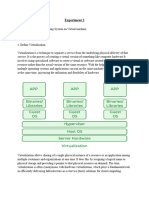0% found this document useful (0 votes)
25 views2 pagesVirtualization at The OS Level
OS-level virtualization, or containerization, allows multiple isolated user-space instances called containers to run on the same physical machine by sharing the host OS kernel. It offers benefits such as lightweight operation, faster boot times, and better resource efficiency, making it ideal for data centers and cloud environments. Key tools for OS-level virtualization include Docker, Kubernetes, and LXC.
Uploaded by
muhammadkamran3980Copyright
© © All Rights Reserved
We take content rights seriously. If you suspect this is your content, claim it here.
Available Formats
Download as PDF, TXT or read online on Scribd
0% found this document useful (0 votes)
25 views2 pagesVirtualization at The OS Level
OS-level virtualization, or containerization, allows multiple isolated user-space instances called containers to run on the same physical machine by sharing the host OS kernel. It offers benefits such as lightweight operation, faster boot times, and better resource efficiency, making it ideal for data centers and cloud environments. Key tools for OS-level virtualization include Docker, Kubernetes, and LXC.
Uploaded by
muhammadkamran3980Copyright
© © All Rights Reserved
We take content rights seriously. If you suspect this is your content, claim it here.
Available Formats
Download as PDF, TXT or read online on Scribd
/ 2





























































